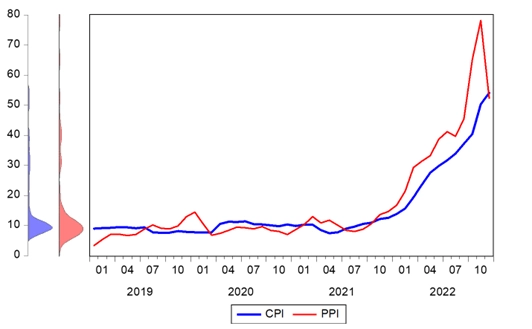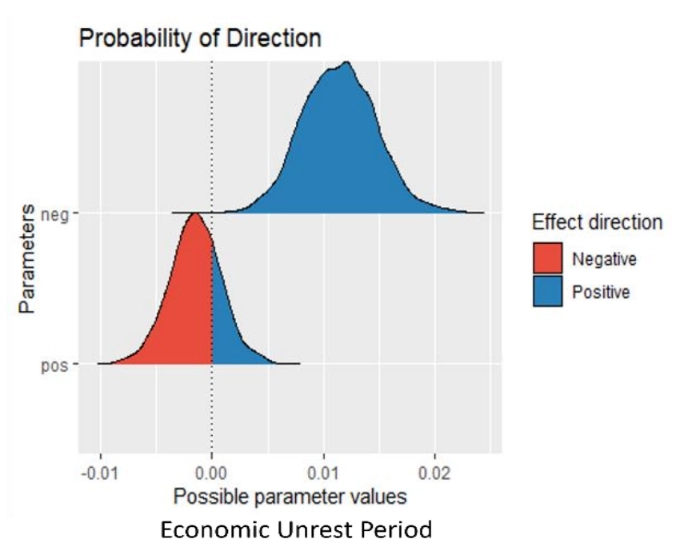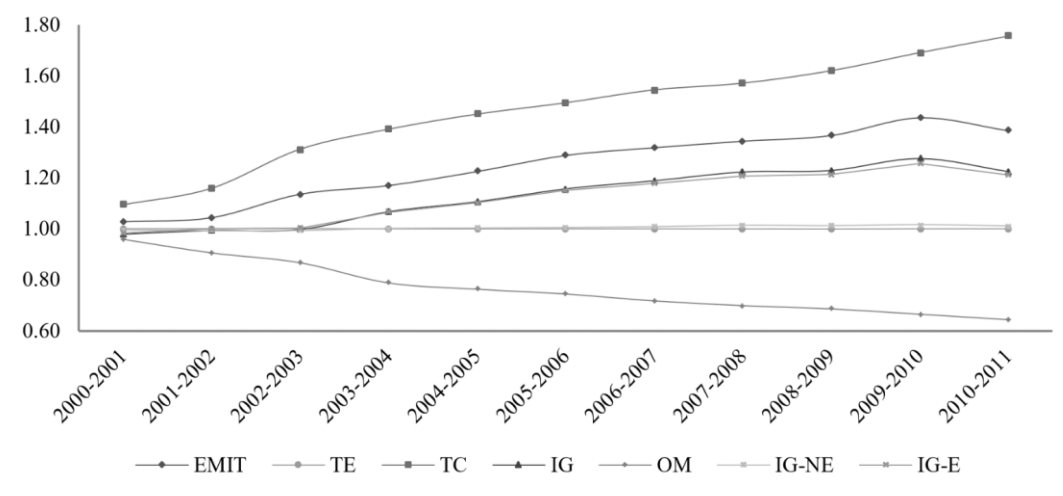The Driving Force of CO2 Reduction in China’s Industries
Abstract
We employ the joint production decomposition model to conduct a full decomposition of CO2 emission among 36 industrial sectors in China from 1998 to 2011, under the framework of growth accounting. The results show that: (1) the average CO2 emission increases at an annual rate of 3.01%, and production technology progression is the main driving force, while the transformation toward clean production effectively curb the rapid growth of CO2 emissions; (2) the effect of technology changes on CO2 emission is larger during the "10th Five-Year Plan" compared with the "11th Five-Year Plan", which makes the annual growth rate of CO2 emission during the "11th Five-Year Plan" 1% lower than its counterpart; This study has important theoretical and practical significance for understanding the driving factors of CO2 emission and the corresponding emission reduction measures.
Cite This Paper
Liu, L., & You, C. (2022). The Driving Force of CO2 Reduction in China’s Industries. Financial Economics Letters, 1(1), 5. doi:10.58567/fel01010005
Liu, L.; You, C. The Driving Force of CO2 Reduction in China’s Industries. Financial Economics Letters, 2022, 1, 5. doi:10.58567/fel01010005
Liu L, You C. The Driving Force of CO2 Reduction in China’s Industries. Financial Economics Letters; 2022, 1(1):5. doi:10.58567/fel01010005
Liu, Lu; You, Chengzhao 2022. "The Driving Force of CO2 Reduction in China’s Industries" Financial Economics Letters 1, no.1:5. doi:10.58567/fel01010005
Show Figures
Share and Cite
Article Metrics
References
- Acemoglu, D.; Aghion, P.; Bursztyn, L.; Hemous, D. The Environment and Directed Technical Change. The American Economic Review 2012, 102, 131-166.
- Allan, G. J.; Hanley, N. D.; McGregor, P. G.; Swales, J. K.; Turner, K. R. The Impact of Increased Efficiency in the Industrial Use of Energy: A Computable General Equilibrium Analysis for the United Kingdom. Energy Economics 2007, 29, 779-798.
- Chang, H.; Wang, W.; Yu, J. Revisiting the Environmental Kuznets Curve in China: A Spatial Dynamic Panel Data Approach. Energy Economics 2021, 104, 105600.
- Chen, Y.; Lee, C. C. Does Technological Innovation Reduce CO2 Emissions Cross-Country Evidence. Journal of Cleaner Production 2020, 263, 121550.
- Cheng, S.; Fan, W.; Meng, F.; Chen, J.; Liang, S.; Song, M.; Liu, G.; Casazza, M. Potential Role of Fiscal Decentralization on Interprovincial Differences in CO2 Emissions in China. Environmental Science & Technology 2021, 55, 813-822.
- Chung, Y. H.; Färe, R.; Grosskopf, S. Productivity and Undesirable Outputs: A Directional Distance Function Approach. Microeconomics 1997, 51, 229-240.
- Copeland, B. R.; Scott, T. M. North-South Trade and the Environment. Quarterly Journal of Economics 1994, 109, 755-787.
- Dong, F.; Wang, Y.; Su, B.; Hua, Y.; Zhang, Y. The Process of Peak CO2 Emissions in Developed Economies: A Perspective of Industrialization and Urbanization. Resources, Conservation and Recycling 2019, 141, 61-75.
- Du, K.; Li, P.; Yan, Z. Do Green Technology Innovations Contribute to Carbon Dioxide Emission Reduction? Empirical Evidence from Patent Data. Technological Forecasting and Social Change 2019, 146, 297-303.
- Färe, R.; Grosskopf, S.; Lovell, C. K. Production Frontiers; Cambridge University Press: Cambridge, UK, 1994.
- Färe, R.; Grosskopf, S.; Noh, D.; Weber, W. Characteristics of a Polluting Technology: Theory and Practice. Journal of Econometrics 2005, 126, 469-492.
- Färe, R.; Grosskopf, S.; Pasurka, C. A. Accounting for Air Pollution Emissionsin Measures of State Manufacturing Productivity Growth. Journal of Regional Science 2001, 41, 381-409.
- Hanley, N.D.; McGregor, P.G.; Swales, J.K.; Turner, K. Do Increases in Energy Efficiency Improve Environmental Quality and Sustainability? Ecological Economics 2009, 68, 692-709.
- Koopman, R.; Wang, Z.; Wei, S. Tracing Value-Added and Double Counting in Gross Exports. The American Economic Review 2014, 104, 459-494.
- Lai, S.; Lu, J.; Luo, X.; Ge, J. Carbon Emission Evaluation Model and Carbon Reduction Strategies for Newly Urbanized Areas. Sustainable Production and Consumption 2022, 31, 13-25.
- Lee, J. D.; Park, J. B.; Kim, T. Y. Estimation of the Shadow Prices of Pollutants with Production/Environment Inefficiency Taken Into Account: A Nonparametric Directional Distance Function Approach. Journal of Environmental Management 2002, 64, 365-375.
- Li, K.; Lin, B. Metafroniter Energy Efficiency with CO 2 Emissions and Its Convergence Analysis for China. Energy Economics 2015, 48, 230-241.
- Li, S.; Chan, H. Decomposing Output Growth in the Presence of Multiple Outputs. Hong Kong Baptist University, 1998.
- Li, W.; Elheddad, M.; Doytch, N. The Impact of Innovation on Environmental Quality: Evidence for the Non-Linear Relationship of Patents and CO2 Emissions in China. Journal of Environmental Management 2021, 292, 112781.
- Liao, X.; Zhao, X.; Liu, W.; Li, R.; Wang, X.; Wang, W.; Tillotson, M. Comparing Water Footprint and Water Scarcity Footprint of Energy Demand in China’s Six Megacities. Applied Energy 2020, 269, 115137.
- Lin, B.; Ma, R. Green Technology Innovations, Urban Innovation Environment and CO2 Emission Reduction in China: Fresh Evidence from a Partially Linear Functional-Coefficient Panel Model. Technological Forecasting and Social Change 2022, 176, 121434.
- Ng, Y. K. Sustainable Development: A Problem of Environmental Disruption Now Instead of Intertemporal Ethics. Sustainable Development 2004, 12, 150-160.
- Pastor, J. T.; Asmild, M.; Lovell, C. A. K. The Biennial Malmquist Productivity Change Index. Socio-Economic Planning Sciences 2011, 45, 10-15.
- Pasurka, C. A. Decomposing Electric Power Plant Emissions within a Joint Production Framework. Energy Economics 2006, 28, 26-43.
- Sueyoshi, T.; Goto, M. DEA Radial and Non-Radial Models for Unified Efficiency under Natural and Managerial Disposability: Theoretical Extension by Strong Complementary Slackness Conditions. Energy Economics 2012b, 34, 700-713.
- Sueyoshi, T.; Goto, M. Undesirable Congestion Under Natural Disposability and Desirable Congestion Under Managerial Disposability in US Electric Power Industry Measured by DEA Environmental Assessment. Energy Economics 2016, 55, 173-188.
- Sueyoshi, T.; Goto, M. Weak and Strong Disposability Vs. Natural and Managerial Disposability in DEA Environmental Assessment: Comparison Between Japanese Electric Power Industry and Manufacturing Industries. Energy Economics 2012a, 34, 686-699.
- Tang, X.; Zhang, W.; Lin, W.; Lao, H. Low-Carbon Sustainable Development of China's Manufacturing Industries Based on Development Model Change. Science of The Total Environment 2020, 737, 140397.
- Turner, K. Negative Rebound and Disinvestment Effects in Response to an Improvement in Energy Efficiency in the UK Economy. Energy Economics 2009, 31, 648-666.
- Wang, Q.; Su, M. The Effects of Urbanization and Industrialization on Decoupling Economic Growth from Carbon Emission–A Case Study of China. Sustainable Cities and Society 2019, 51, 101758.
- Wang, Q.; Su, M.; Li, R. Toward to Economic Growth without Emission Growth: The Role of Urbanization and Industrialization in China and India. Journal of Cleaner Production 2018, 205, 499--511.
- Wang, X.; Wang, Y. Regional Unified Environmental Efficiency of China: A Non-Separable Hybrid Measure Under Natural and Managerial Disposability. Environmental Science and Pollution Research 2020, 27, 27609-27625.
- Wang, Z.; Wei, S.; Yu, X.; Zhu, K. Measures of Participation in Global Value Chains and Global Business Cycles. NBER Working Paper No. w23222, 2017.
- Wei, Y. D.; Liefner, I. Globalization, Industrial Restructuring, and Regional Development in China. Applied Geography 2012, 32, 102-105.
- Wu, J.; Zhu, Q.; Liang, L. CO2 Emissions and Energy Intensity Reduction Allocation over Provincial Industrial Sectors in China. Applied Energy 2016, 166, 282-291.
- Wurlod, J.; Noailly, J. The Impact of Green Innovation on Energy Intensity: An Empirical Analysis for 14 Industrial Sectors in OECD Countries. Energy Economics 2018, 71, 47-61.
- Xu, L.; Fan, M.; Yang, L.; Shao, S. Heterogeneous Green Innovations and Carbon Emission Performance: Evidence at China's City Level. Energy Economics 2021, 99, 105269.
- Yang, H.; Pollitt, M. The Necessity of Distinguishing Weak and Strong Disposability Among Undesirable Outputs in DEA: Environmental Performance of Chinese Coal-Fired Power Plants. Energy Policy 2010, 38, 4440-4444.
- Zhang, W.; Lin, W.; Li, Z. How the Growth Rate Influences Low-Carbon Sustainable Production Performance under Different Disposabilities in China's Manufacturing Industries? Journal of Cleaner Production 2019, 249, 119349.
- Zheng, W.; Walsh, P. P. Economic Growth, Urbanization and Energy Consumption–A Provincial Level Analysis of China. Energy Economics 2019, 80, 153-162.


